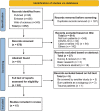Efficacy and safety of extracorporeal membrane oxygenation for burn patients: a comprehensive systematic review and meta-analysis
- PMID: 36873286
- PMCID: PMC9977350
- DOI: 10.1093/burnst/tkac056
Efficacy and safety of extracorporeal membrane oxygenation for burn patients: a comprehensive systematic review and meta-analysis
Abstract
Background: Respiratory and circulatory dysfunction are common complications and the leading causes of death among burn patients, especially in severe burns and inhalation injury. Recently, extracorporeal membrane oxygenation (ECMO) has been increasingly applied in burn patients. However, current clinical evidence is weak and conflicting. This study aimed to comprehensively evaluate the efficacy and safety of ECMO in burn patients.
Methods: A comprehensive search of PubMed, Web of Science and Embase from inception to 18 March 2022 was performed to identify clinical studies on ECMO in burn patients. The main outcome was in-hospital mortality. Secondary outcomes included successful weaning from ECMO and complications associated with ECMO. Meta-analysis, meta-regression and subgroup analyses were conducted to pool the clinical efficacy and identify influencing factors.
Results: Fifteen retrospective studies with 318 patients were finally included, without any control groups. The commonest indication for ECMO was severe acute respiratory distress syndrome (42.1%). Veno-venous ECMO was the commonest mode (75.29%). Pooled in-hospital mortality was 49% [95% confidence interval (CI) 41-58%] in the total population, 55% in adults and 35% in pediatrics. Meta-regression and subgroup analysis found that mortality significantly increased with inhalation injury but decreased with ECMO duration. For studies with percentage inhalation injury ≥50%, pooled mortality (55%, 95% CI 40-70%) was higher than in studies with percentage inhalation injury <50% (32%, 95% CI 18-46%). For studies with ECMO duration ≥10 days, pooled mortality (31%, 95% CI 20-43%) was lower than in studies with ECMO duration <10 days (61%, 95% CI 46-76%). In minor and major burns, pooled mortality was lower than in severe burns. Pooled percentage of successful weaning from ECMO was 65% (95% CI 46-84%) and inversely correlated with burn area. The overall rate of ECMO-related complications was 67.46%, and infection (30.77%) and bleedings (23.08%) were the two most common complications. About 49.26% of patients required continuous renal replacement therapy.
Conclusions: ECMO seems to be an appropriate rescue therapy for burn patients despite the relatively high mortality and complication rate. Inhalation injury, burn area and ECMO duration are the main factors influencing clinical outcomes.
Keywords: Acute respiratory distress syndrome; Burns; Extracorporeal membrane oxygenation; Inhalation injury.
© The Author(s) 2023. Published by Oxford University Press.
Figures







Similar articles
-
[Clinical application of extracorporeal membrane oxygenation in the treatment of burn patients with acute respiratory distress syndrome: a retrospective analysis and systematic review].Zhonghua Shao Shang Za Zhi. 2021 Oct 20;37(10):911-920. doi: 10.3760/cma.j.cn501120-20210803-00266. Zhonghua Shao Shang Za Zhi. 2021. PMID: 34689460 Free PMC article. Chinese.
-
Benefit of extracorporeal membrane oxygenation in major burns after stun grenade explosion: Experience from a single military medical center.Burns. 2017 May;43(3):674-680. doi: 10.1016/j.burns.2016.08.035. Epub 2016 Dec 28. Burns. 2017. PMID: 28040370
-
Revisiting extracorporeal membrane oxygenation for ARDS in burns: A case series and review of the literature.Burns. 2018 Sep;44(6):1433-1438. doi: 10.1016/j.burns.2018.05.008. Epub 2018 Jun 11. Burns. 2018. PMID: 29903600 Review.
-
The Use of Extracorporeal Membrane Oxygenation for Burns: A Systematic Review and Meta-Analysis.ASAIO J. 2023 Jan 1;69(1):e7-e13. doi: 10.1097/MAT.0000000000001839. Epub 2022 Oct 26. ASAIO J. 2023. PMID: 36302307
-
Extracorporeal membrane oxygenation support may be a lifesaving modality in patients with burn and severe acute respiratory distress syndrome: Experience of Formosa Water Park dust explosion disaster in Taiwan.Burns. 2018 Feb;44(1):118-123. doi: 10.1016/j.burns.2017.06.013. Epub 2017 Jul 27. Burns. 2018. PMID: 28756973
Cited by
-
Early extracorporeal membranous oxygenation and burn excision in severe burn and inhalation injury.Scars Burn Heal. 2024 Dec 11;10:20595131241302942. doi: 10.1177/20595131241302942. eCollection 2024 Jan-Dec. Scars Burn Heal. 2024. PMID: 39665048 Free PMC article.
-
Deployable machine learning-based decision support system for tracheostomy in acute burn patients.Burns Trauma. 2025 May 13;13:tkaf010. doi: 10.1093/burnst/tkaf010. eCollection 2025. Burns Trauma. 2025. PMID: 40365530 Free PMC article.
References
-
- Swanson JW, Otto AM, Gibran NS, Klein MB, Kramer CB, Heimbach DM, et al. Trajectories to death in patients with burn injury. J Trauma Acute Care Surg. 2013;74:282–8. - PubMed
-
- Wang B, Chenru W, Jiang Y, Hu L, Fang H, Zhu F, et al. Incidence and mortality of acute respiratory distress syndrome in patients with burns: a systematic review and meta-analysis. Front Med (Lausanne). 2021;8:709642. https://www.frontiersin.org/articles/10.3389/fmed.2021.709642/full. - DOI - PMC - PubMed
LinkOut - more resources
Full Text Sources

